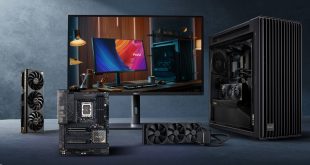For the M4A89GTD, Asus have stuck with their usual colour scheme which features blue fittings on a black PCB. This looks great and should fit in well aesthetically with most setups. It is clear from a glance that Asus havve designed this board with overclocking in mind due to the sizable heatsink that cools the electrical components surrounding the CPU socket. Of course part of this covers the northbridge as AMD have yet to combine them into a single chip.
Asus have decided to use the AMD 890GX chipset for this board which supports DDR3 memory and has an integrated Radeon HD 4290 IGP. We don't expect that many people who purchase this high-end board will make use of the IGP, though, as they are likely to opt for a more powerful dedicated solution.
The M4A90GTD Pro/USB3 supports Crossfire through the two PCIe x8 lanes. If you plan to use a single card setup, you need to install a ‘VGA Switch Adapter' into the top PCIe slot to enable full PCI x16 functionality in the primary (blue) slot. Asus also include a PCI Express x4 slot a PCI Express x1 slot and two PCI slots for expansion cards.
As usual, the RAM slots flank the CPU socket on the right hand side. There are four of them in total, supporting up to 16GB of 1333MHz (or 1866MHz OC) memory. Those who plan to use a sizable CPU heatsink should be aware that these are very close to the CPU socket so low profile memory will be required.
In the bottom right corner of the board we find six SATA 6Gbps ports which support RAID 0, 1 and 5. Two of these are attached at 90 degrees to the board to aid cable management. The IDE connector is also angled at 90 degrees but we doubt that many people will actually use this. As usual, we also find the front panel connectors in the bottom right corner of the board. Installling these is made a lot easier by Asus' ‘Q-connector' which prevents installation.
The vast selection of I/O connections certainly reflects the high-end nature of this board. The two USB3.0 ports on the back panel are accompanied by two USB2.0 ports and four internal USB2.0 headers which add the possibility of a further eight connectors. There is also a PS2 connector, VGA, DVI and HDMI connectors, an RJ-45 ethernet jack and an eSATA port. Audio connectivity is catered for by six 3.5mm jacks and a optical S/PDIF connection.
 KitGuru KitGuru.net – Tech News | Hardware News | Hardware Reviews | IOS | Mobile | Gaming | Graphics Cards
KitGuru KitGuru.net – Tech News | Hardware News | Hardware Reviews | IOS | Mobile | Gaming | Graphics Cards









